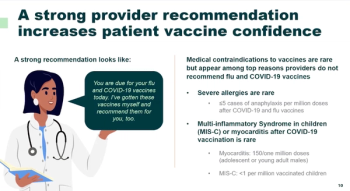
New nanoparticle flu vaccine could benefit senior patients
A new vaccine in development could provide increased flu protection for seniors.
A new seasonal influenza vaccine aimed at senior patients is moving forward in the clinical trials process after showing early success in offering additional protection to this particularly susceptible population.
Influenza can be particularly dangerous for adults aged 65 and older, due to weakened immune systems and other chronic conditions, according to the CDC. While traditional flu vaccines are highly effective in reducing prevalence and severity of the flu in this population, this new vaccine targets antigens in local lymph nodes, resulting on potent protection and reduced side effects in older adults.
The new nanoparticle vaccine, NanoFlu, has moved forward to
The Phase 2 trial began in September and will test both adjuvanted with Matrix-M and unadjuvanted versions of the vaccine, said Gregory M. Glenn, MD, president of research and development at Novavax, the company developing NanoFlu.
“Our recombinant seasonal influenza vaccine is produced to display the exact sequence of hemagglutinin antigen found on circulating influenza viruses, a key advantage compared to egg-based influenza vaccines, which have been shown to have sequence mutations arising during production,” Glenn said. “Our recombinant influenza nanoparticles also display conserved antigenic regions, which have the potential to elicit broadly neutralizing antibodies that appear to protect against a range of ‘drifted’ strains, or influenza strains in which, over time, the hemagglutinin antigen undergoes an accumulation of genetic mutations.”
The use of adjuvant Matrix-M is also a key element of the vaccine, as it increases the overall amount of antibodies produced, Glenn said. Finally, the nanoparticles offer improved purity and manufacturability over other influenza vaccines, he said.
As far as NanoFlu’s other specific differences from traditional flu vaccines, Glenn said this formulation uses wild type HA sequences, a recombinant vaccine.
“We thereby avoid the issue of egg-adaptive antigenic changes, which are known limitations of currently available egg-derived vaccines, adversely impacting clinical effectiveness,” Glenn said. “In early studies, NanoFlu has shown 47 percent to 64 percent improvement in HAI antibody responses compared to the current market leader Fluzone HD targeted at A/H3N2 influence strains.”
Glenn said NanoFlu has also shown effective responses against drifted A/H3N2 viruses.
“Antigenic drift, particularly A/H3N2 drift, is a major reason why current influenza vaccine may perform sub-optimally when there is significant antigenic drift in circulating A/H3N2 viruses; and it’s important to remember that A/H3N2 is responsible for the majority of influenza related hospitalizations and death on a historical basis, and it’s also the strain in current influenza vaccines that performs least well historically,” Glenn said.
Glenn said he hopes the vaccine will help close historic gaps in efficacy with current flu vaccine options.
“The low effectiveness of seasonal influenza vaccines, and in particular the A(H3N2) component of the vaccine, during the 2017-2018 season emphasizes the need for a more effective vaccine,” Glenn said. “Our non-egg-based, recombinant nanoparticle vaccine, when coupled with Matrix-M, potentially offers broader protection against rapidly evolving drift strain variants as well as strains that match the vaccine strains. We believe this addresses important public health challenges caused by influenza and offers a significant advantage over current influenza vaccines.”
Newsletter
Stay informed and empowered with Medical Economics enewsletter, delivering expert insights, financial strategies, practice management tips and technology trends — tailored for today’s physicians.








